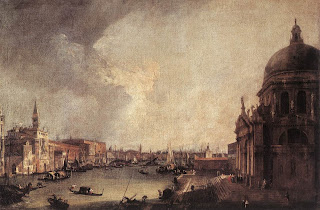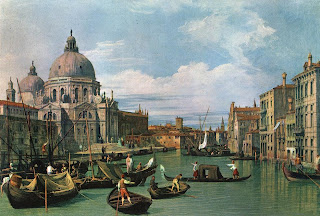Giovanni Antonio Canaletto (1697-1768) |
Giovanni Antonio Canale was born in October 1697 and baptized in the church of San Lio
In 1719, he traveled with his father to Rome Rome
Within the Italian tradition of vedute (view painting) Canaletto explored different forms. He created vedute esatte (precise views), and also vedute ideale (imaginary or fantastic views), which are known as capricci, in these works Canaletto drew together architectural subjects from different sources and arranged them in an imaginative form to create a very consciously fictional and poetic image. Pictures of this type assume knowledge of their subjects on the part of the viewer, and were designed to appeal to the contemporary taste for ruins and the nostalgia they evoked.
In 1720, the artist’s name is first recorded in the register of the Venetian painters’ guild. Venice church of Santi Giovanni Venice
After his success at the public exhibition, Canaletto was commissioned to paint four works for the merchant Stefano Conti (1725). Patrons such as Conti were important to Canaletto at the outset of his career, but it was English collectors who came to dominate the market for his view paintings. According to the fashion of the time it was considered that an essential part of good education and cultivation for the young English gentleman was to travel to Italy and visit the famous places of Rome , Florence and Venice
Canaletto’s earliest work for the ‘English market’ came to him as a result of his contact with an Irishman called Owen McSwiney (c.1684-1754). Their acquaintance took place in 1720s, at least the first documentary mention of paintings, commissioned by Owen McSwiney, referred to 1826. McSwiney not only introduced Canaletto to English customers, but seems also to have encouraged the painter to create works which might particularly appeal to them.
The most important person in Canaletto’s career and his patron was Joseph Smith (c.1674-1770), an Englishman, who lived in Venice, and worked as an agent on behalf of British collectors of manuscripts, books and works of art; he also served as British Consul to the Venice Republic (1744-1760; 1766). He had a notable collection of his own. This collection in 1762-3 was sold to King George III, by that time it included the largest single group of works by Canaletto ever assembled.
In the 1730s, the demand for Canaletto’s work was so large that Canaletto employed studio assistants. Canaletto’s father probably helped him, and certainly Canaletto’s nephew Bernardo Bellotto (1720-80), who at the time was trained in his studio. In 1735, a set of engravings was published by Antonio Visentini after Canaletto’s paintings in Smith’s collection, called the Prospectus Magni Canalis Venetiarum, which also included the portrait of the artist, now considered the only reliable one.
In 1741, the War of the Austrian Succession broke out, which consequently undermined the tourist business; this meant that the artist’s was loosing his principal source of patronage. In addition, perhaps for the first time, Canaletto experienced some serious competition. Canaletto tried to expand the variety of his subjects. In 1740-41, he traveled along the Brenta Canal towards Padua Rome Rome Rome Rome
In 1746 Canaletto arrived in London ; he worked in England England were the views of the Thames and the recently completed Westminster Bridge : London : Westminster Bridge London : Seen through an Arch of Westminster Bridge London London : Whitehall and the Privy Garden London : the Thames and the City of London from Richmond England London
Canaletto returned briefly to Venice in 1751 (and may also have traveled home again in 1753), but then remained in England
In 1755 the artist returned to Venice Venice
In 1763 Canaletto was finally elected to the Venetian Academy church of San Lio


.jpg)






.jpg)


.jpg)











.jpg)




.jpg)






.jpg)
.jpg)






.jpg)



.jpg)

.jpg)








.jpg)




.jpg)

.jpg)
.jpg)



0 comments:
Post a Comment